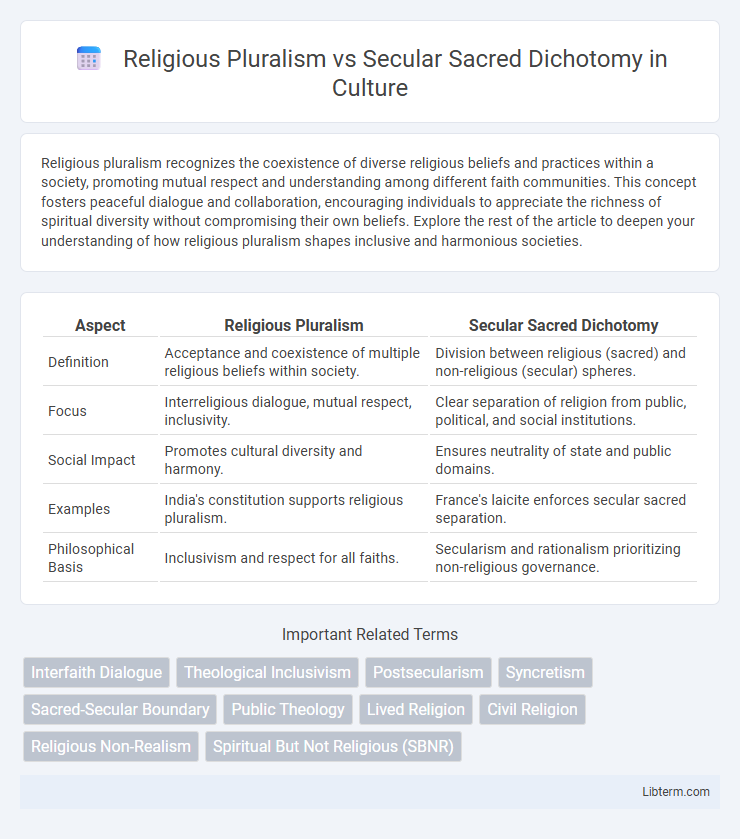Religious pluralism recognizes the coexistence of diverse religious beliefs and practices within a society, promoting mutual respect and understanding among different faith communities. This concept fosters peaceful dialogue and collaboration, encouraging individuals to appreciate the richness of spiritual diversity without compromising their own beliefs. Explore the rest of the article to deepen your understanding of how religious pluralism shapes inclusive and harmonious societies.
Table of Comparison
| Aspect | Religious Pluralism | Secular Sacred Dichotomy |
|---|---|---|
| Definition | Acceptance and coexistence of multiple religious beliefs within society. | Division between religious (sacred) and non-religious (secular) spheres. |
| Focus | Interreligious dialogue, mutual respect, inclusivity. | Clear separation of religion from public, political, and social institutions. |
| Social Impact | Promotes cultural diversity and harmony. | Ensures neutrality of state and public domains. |
| Examples | India's constitution supports religious pluralism. | France's laicite enforces secular sacred separation. |
| Philosophical Basis | Inclusivism and respect for all faiths. | Secularism and rationalism prioritizing non-religious governance. |
Understanding Religious Pluralism: Definitions and Key Concepts
Religious pluralism recognizes the coexistence and mutual respect of diverse religious beliefs within a society, emphasizing dialogue and inclusivity rather than exclusion. It challenges the secular sacred dichotomy, which segregates religious experience from public and civic life, by integrating multiple faith perspectives into social frameworks. Key concepts include acknowledgment of religious diversity, open engagement among different traditions, and the promotion of peaceful coexistence through shared values.
The Secular Sacred Dichotomy: Origins and Evolution
The secular sacred dichotomy emerged during the Enlightenment as intellectuals sought to separate religious authority from state governance and public life, emphasizing rationality and empirical science. This framework evolved through modernity, reflecting tensions between sacred traditions and secular institutions in diverse societies. The dichotomy remains a critical lens for understanding contemporary debates over religious freedom, public morality, and the role of religion in secular states.
Comparative Analysis: Pluralism and the Secular Sacred Divide
Religious pluralism acknowledges the coexistence and equal validity of diverse religious beliefs, promoting interfaith dialogue and mutual respect, while the secular sacred dichotomy separates religious values from secular life, often positioning the sacred as distinct and sometimes opposed to secularism. Comparative analysis reveals that pluralism fosters inclusivity and the blending of sacred experiences within public spheres, whereas the secular sacred divide emphasizes boundaries that can lead to marginalization or compartmentalization of religious identities. Understanding this dynamic is crucial for addressing contemporary challenges in multicultural societies where religion interacts with public policy, social norms, and cultural integration.
Historical Contexts Shaping Both Paradigms
Religious pluralism emerged prominently during the Enlightenment era, challenging dominant religious monopolies by promoting coexistence and mutual respect among diverse faiths. In contrast, the secular sacred dichotomy developed through modernity's separation of church and state, categorizing religion as a private sphere distinct from public life. Historical events such as the Reformation, colonial encounters, and constitutional reforms critically shaped these paradigms by influencing societal attitudes toward religion's role in politics and culture.
Religious Pluralism in Multicultural Societies
Religious pluralism in multicultural societies promotes the coexistence of diverse faiths by encouraging mutual respect and dialogue among different religious traditions. This approach fosters social cohesion and inclusivity, allowing individuals to freely practice and express their beliefs without marginalization. Emphasizing shared values and common ethical principles helps bridge the gap between various religious communities, challenging the rigid boundaries of the secular sacred dichotomy.
The Role of Secularism in Modern Governance
Secularism in modern governance ensures the separation of religious institutions from state affairs, promoting neutrality and equal treatment of diverse faiths under the law. This framework supports religious pluralism by allowing multiple religious traditions to coexist without state endorsement or favoritism, fostering social harmony and protecting individual freedoms. By maintaining a secular public sphere, governments prevent religious dominance, thereby upholding democratic principles and safeguarding minority rights.
Interfaith Dialogue and the Challenge of Dichotomy
Interfaith dialogue confronts the challenge of the religious pluralism versus secular sacred dichotomy by fostering mutual understanding among diverse faith communities and secular perspectives. This dialogue emphasizes shared values and ethical principles, transcending the binary opposition between sacred religious beliefs and secular worldviews. Navigating this dichotomy requires acknowledging the legitimacy of multiple sacred traditions while promoting inclusive spaces for cooperative engagement across religious and secular divides.
Case Studies: Religious Pluralism vs. Secularism in Practice
Case studies on religious pluralism versus secularism highlight diverse approaches to managing faith in public domains, such as India's constitutional commitment to religious diversity alongside state secularism and France's strict laicite enforcing religious neutrality in public institutions. India's model facilitates interfaith dialogue and legal protections for minority religions, fostering coexistence in a multi-religious society, while French secularism prioritizes separation of religion and state, often restricting religious expressions in public spaces to maintain neutrality. These contrasting practices illuminate the complexities and outcomes of balancing religious freedom and secular governance within pluralistic societies.
Impacts on Social Cohesion and Identity Formation
Religious pluralism fosters social cohesion by encouraging mutual respect and dialogue among diverse faith communities, which strengthens inclusive identity formation within multicultural societies. In contrast, the secular sacred dichotomy often creates a divide by privileging secular values over religious expressions, potentially leading to social fragmentation and identity conflicts. Balancing these dynamics is crucial for harmonious coexistence and the development of cohesive social identities in pluralistic environments.
Future Directions: Bridging Divides in an Increasingly Pluralistic World
Future directions in addressing the divide between religious pluralism and the secular sacred dichotomy emphasize fostering interfaith dialogue and inclusive policies that respect diverse belief systems. Embracing interdisciplinary approaches integrating theology, sociology, and political science supports the creation of frameworks where secular and sacred values coexist harmoniously. Advancing educational initiatives that cultivate empathy and understanding can bridge divides and promote social cohesion in an increasingly pluralistic global society.
Religious Pluralism Infographic

 libterm.com
libterm.com